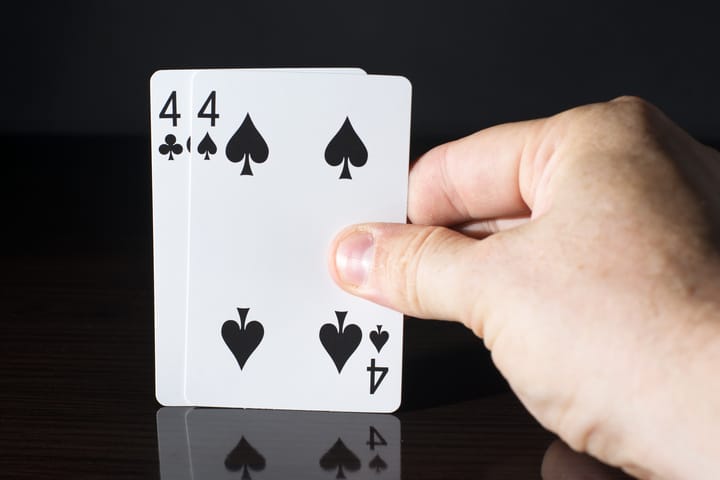Standard Card Deck – How Many Cards Are in a Deck and What Else You Need To Know?

8 minutes
Last Updated: March 19, 2024
Images from shutterstock.com
Over the course of history, humankind has invented thousands of different games to keep occupied, pass the time, and compete. Few requisites have been used in as many different games as playing cards.
Dating back to the 9th century, the first playing cards were invented in China. This is also the time when the first card games were created and written about.
Today, we use playing cards to play blackjack, baccarat, poker, and many other games, but the mystique behind them has not diminished over the centuries.
Whether they are the tools of your trade or you believe them to be cursed, you have to admit there is something magical and beautiful in holding a standard deck of cards, shuffling through it, and dealing them out.
Today, I want to look at where playing cards came from, how decks of cards look today, how many cards are in a deck, and how they are distinguished from each other.
To get started, let’s look at the history of playing cards before all other things.
The History of Playing Cards
People have gambled pretty much since the dawn of time. That said, there was no way to print cards before the 9th century. It was at that point that printing became possible, and the first playing cards were created.
While it is not clear who exactly came up with the very first card deck, we know that they were created during the Tang Dynasty. The first mention of them is found in the “Collection of Miscellanea at Duyang,” which was written by Su E.
The first game ever played with primitive cards was referred to as “the leaf game.”
While the rules of this game were lost to time, it is clear that it was played by the Chinese elite during the Tang Dynasty.
The first mention of playing cards similar to ours was also in China, with 15th-century scholar Lu Roang. He describes a deck of playing cards that has 38 cards organized in 4 suits and with different ranks.

In Arabia, cards very similar to our modern ones were used by the middle ages. There were 48 cards in the card deck, 12 in each of the four suits. Each suit had ten pip cards and two face cards, the sultan and the vizier.
Origins of Playing Cards in Europe
We don't know when exactly playing cards reached Europe. However, we do know that the first written record of them came from 1367 when they were legally banned in the city of Berne. An even more credible source talks of a cards' ban in Florence in 1377.
These early European cards carried the suits that were copied from the Arabic cards, with polo bats, swords, coins, and cups appearing as the four suits.
Cards quickly spread across Italy, Germany, England, and more. They were hard to come by and expensive. In the early days, only the rich and the noble had access to real decks of playing cards.
Early decks of cards were not uniform, as the royalty cards would be different across different countries, with queen or jack (the prince) cards appearing in one deck of cards and not in other. The king was uniformly the most valuable card in most decks.
After the middle ages, when the bans ended, playing cards had a revolution of sorts. Dozens of printing companies appeared, and it became much easier to acquire a deck of cards.
The invention of reversible royalty cards and uniformity of suits followed as well. Still, players in different countries had problems agreeing on these throughout the 17th, 18th, and 19th centuries.
As cards made their way across the ocean and into America, the joker card was also introduced. It was initially created for the game of euchre. Jokers were not wild cards right away, and it seems they were introduced as such in the late 19th century for certain types of poker games.

Over the years, numerous decks of cards were created, and today thousands of people collect playing cards from different parts of the world.
Even today, the standard deck of playing cards is not the only one played with. Many people use different suits and decks for various traditional card games.
Standard Card Decks in the 21st century
While I did mention that there are many different types of playing cards, the contemporary deck is present more than any other type and used in all countries of the world to play games like poker.
This deck of cards came from the French, with modern-day clubs, diamonds, hearts, and spades. These were originally called clovers, tiles, hearts, and pikes.
If you were to travel across the world, you could find cards with suits like shields, acorns, coins, swords, leaves, and many others, all coming from the local traditions.
Now that we have covered the history, let's talk about the card deck as most of us know it. A standard card deck used today comes with 52 cards grouped into four suits.
This means there are 13 cards of each suit, and these are clubs, diamonds, hearts, and spades.
The low-value cards are called pips, and they have numerical values between one and ten. The highest-ranked cards are royalties, which are the jack, the queen, and the king.
In many games, like poker, the ace card actually has the highest value and outranks all others. The numerical value of an ace can change between 1 and 11 in games like blackjack.
The value of suits is identical in some games, while in others, the alphabetical order of the suits is determined to rank them and know which ones are valued the most, with spades coming out on top.
The 52 deck of cards also comes with two joker cards in most cases. These are used in some games such as rummy and can be discarded when playing poker, blackjack, or baccarat.
A stripped deck of cards is sometimes used as well, with twos, threes, fours, fives, and sixes getting removed from the deck to form a 32 card deck for games like belote or skat.
Special Card Names You Should Know
Now that you know how many cards are in a deck and the types of cards in a deck, there is also some fun trivia to learn about the playing cards.
As you know, each card has its official name, and these are pretty boring and mundane. However, that doesn't mean these are the only names for the cards in a deck.
In fact, some interesting alternative names exist for many cards, and there is a story behind each one.
So, here are a few popular cards that you will see in any deck that have a special story behind them:
The Death Card
Ace of spades is the highest-ranking card in a deck and the one you will usually see first when you open a new box of cards. Back in 19th century England, it was a capital offense to forge an ace of spades since this was the one card in the deck that would be stamped. This is likely where the card got its ominous name as the death card.

The Beer Card
The name comes from a fairly provisional side bet that was often used in trick-taking games in Denmark. The player who would win the last trick with a seven of diamonds should buy a round of beer for the entire group. If you play trick games like spades, you can include the side bet too and spice up the action.
The Curse of Scotland
As the legend has it, the order for the Glencoe Massacre in 1692 was written on a playing card. That card was a nine of diamonds. Whether the legend is true or not isn’t quite clear, but the one thing we know is that people don’t look kindly on this card in Scotland.
The Devil’s Bedpost
The origin of this name for the four of clubs is quite clear, as the design of the card and the pips on it appear as the four posts of a deathbed. The four of clubs is often considered a cursed card and one that should be avoided in play at all cost by those who believe in such superstitions.

The Flower Queen
The royalty cards are drawn differently in various card decks, but the queen of clubs is always depicted as holding a flower. This distinctive detail on the card gave it the name of the Flower Queen, and it’s one that doesn’t come with any special superstitions attached.
The Black Lady
Also known as the Black Widow, the queen of spades got its name from the popular game of Hearts. In this game, the players try to avoid collecting points, and the queen of spades gives a massive 13 points at once to the player who picks it up. Thus, the card is named the Black Lady as the ominous sign of impending defeat that it is.
The Suicide King
The only king in the standard card deck that doesn't have a mustache, the king of hearts is known as the Suicide King. The king holds a sword, seemingly stabbing himself in the head with it. The original intention was likely for the sword to be behind his head, but the name Suicide King stuck around despite that.
The Man with the Axe
Unlike the king of hearts who is armed with a sword, the king of diamonds uses an ax as his weapon of choice. The king of diamonds is thus referred to as the Man with the Axe. Put the two together, and you get a pair of cowboys, as they are often referred to as in poker hands rankings.
The Royal Family
Now that you know some popular card deck nicknames, here is another fun piece of trivia you maybe didn’t know about. The royal cards in the standard deck of cards actually have real human names.
This is a fact that isn't too often known by card players since these names aren't revealed on the cards themselves.
So, here are the names of each member of the royal family you will find in a card deck:
| Suit | Jack | Queen | King |
| Clubs | Lancelot | Argine | Alexandre |
| Diamonds | Hector | Rachel | Caesar |
| Hearts | Lahire | Judith | Charles |
| Spades | Ogier | Pallas | David |
Don’t expect others to know these deck of card names because they are seldom actually used. However, if you want to impress your fellow players at the next home game, you can spring this newly found knowledge on them and have some laughs.
Shuffle Up and Deal
You now know how many cards are in a deck, what types of playing cards you will find in there, and what special names some of the cards have.
That’s all just the first step to learning how to play some exciting card games. In many of them, you will actually need to know how many cards are out there and what cards are still in the deck.
Go ahead and take a deck of cards and play with it. Try to remember how many spades are in a deck of cards, how many queens or kings there are, and how you can combine the cards for different games.
There are countless games you can play with them, so knowing the deck inside and out will be of great help as you go ahead and try to learn some of them. This is also a crucial part of information if you want to become good at Texas Hold’em Poker.
Card Deck FAQ
To wrap up this article on standard card decks, here's a quick FAQ, reiterating some of the most important points and most interesting details that you should know about playing cards.
How many cards are in a deck?
The standard deck of cards has 52 cards in it. There are 12 royalty cards and 40 pip cards. The pip cards have numbers on them, while the royalty cards come with images of jacks, queens, and kings. The ace cards are pip cards but are often the top-ranked ones.
How many suits are there in the cards, and what are they?
There is a total of four suits in a standard card deck. The suits, in alphabetical order, are clubs, diamonds, hearts, and spades. This same order is used in some games to determine which suit is the most valuable one, when necessary.
How many cards are there in each suit?
There is a total of 52 cards in a deck, and these are equally split up into four suits. That means there is a total of 13 cards in each suit. There are three face cards of each suit, one ace, and the remaining nine cards come with pips.
Are face cards more valuable than pips?
The value of cards really depends on the game you are playing. In most games, face cards are considered the most valuable. The ace card has the highest value in some games, such as poker. Face cards are sometimes assigned numerical value as well, such as 12 for jacks, 13 for queens, and 14 for kings.
What kind of games can I play with a standard deck of cards?
There is a vast number of games you can play with a 52 card deck. Some popular ones include poker, euchre, rummy, blackjack, baccarat, hearts, bridge, and many more. There are also many traditional games that are played only in some countries or parts of the world.




















